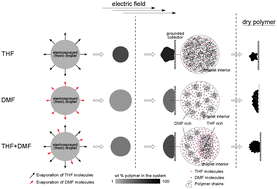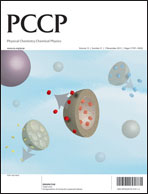Molecular basis for solvent dependent morphologies observed on electrosprayed surfaces†
Abstract
We study the causes of the observed tunable hydrophobicity of poly(styrene-co-perfluoroalkyl ethylacrylate) electrosprayed in THF, DMF, and THF : DMF (1 : 1) solvents. Under the assumption that equilibrium morphologies in the solvent significantly affect the patterns observed on electrosprayed surfaces, we use atomistic and coarse-grained simulations supported by dynamic light scattering (DLS) experiments to focus on the parameters that affect the resulting morphology of superhydrophobic electrosprayed beads. The differing equilibrium chain size distributions in these solvents examined by DLS are corroborated by chain dimensions obtained via molecular dynamics simulations. Mesoscopic morphologies monitored by dissipative particle dynamics simulations explain experimental observations; in particular, the preference of the polymer for THF over DMF in the binary mixture rationalizes the dual scale roughness driven by stable microphase separation. Drying phenomena that affect resultant dual-scale roughness are described in three stages, each interpreted by concentration dependent diffusion and surface mass transfer coefficients of the solvents. Irrespective of the presence of polar groups in the structure, a conflict between the lower-boiling point solvent adhering to the polymer and the less volatile solvent abundant in the bulk leads to perfectly hydrophobic surfaces.


 Please wait while we load your content...
Please wait while we load your content...